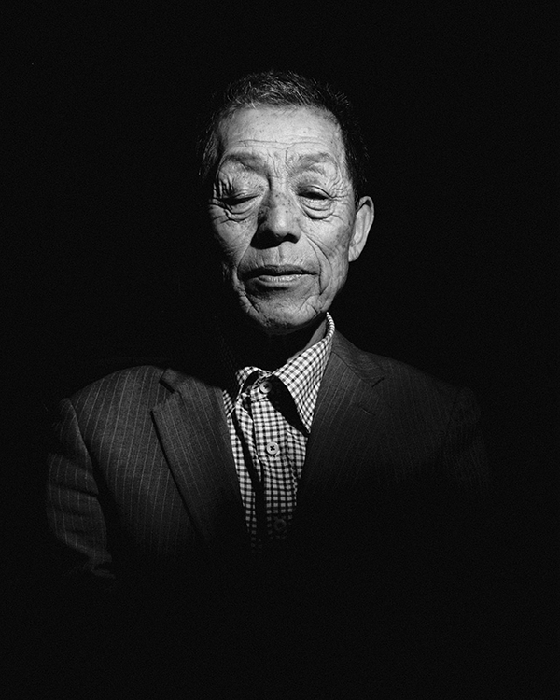
After The Bomb
Survivors of the Atomic Blasts in Hiroshima and Nagasaki share their stories
Photographs by HARUKA SAKAGUCHI | Introduction By LILY ROTHMAN
When the nuclear age began, there was no mistaking it. The decision by the United States to drop the world’s first atomic weapons on two Japanese cities—Hiroshima first, on Aug. 6, 1945, and Nagasaki three days later—was that rare historical moment that requires little hindsight to gain its significance. World War II would end, and the Cold War soon begin. New frontiers of science were opening, along with new and frightening moral questions. As TIME noted in the week following the bombings, the men aboard the Enola Gay could only summon two words: “My God!”
But, even as world leaders and ordinary citizens alike immediately began struggling to process the metaphorical aftershocks, one specific set of people had to face something else. For the survivors of those ruined cities, the coming of the bomb was a personal event before it was a global one. Amid the death and destruction, some combination of luck or destiny or smarts saved them—and therefore saved the voices that can still tell the world what it looks like when human beings find new and terrible ways to destroy one another.
Today, photographer Haruka Sakaguchi is seeking out those individuals, asking them to give a testimony about what they lived through and to write a message to future generations. As the anniversaries of the bombings approach once again, here is a selection of that work.
Yasujiro Tanaka
age: 75 / location: nagasaki / DISTANCE from hypocenter: 3.4 km
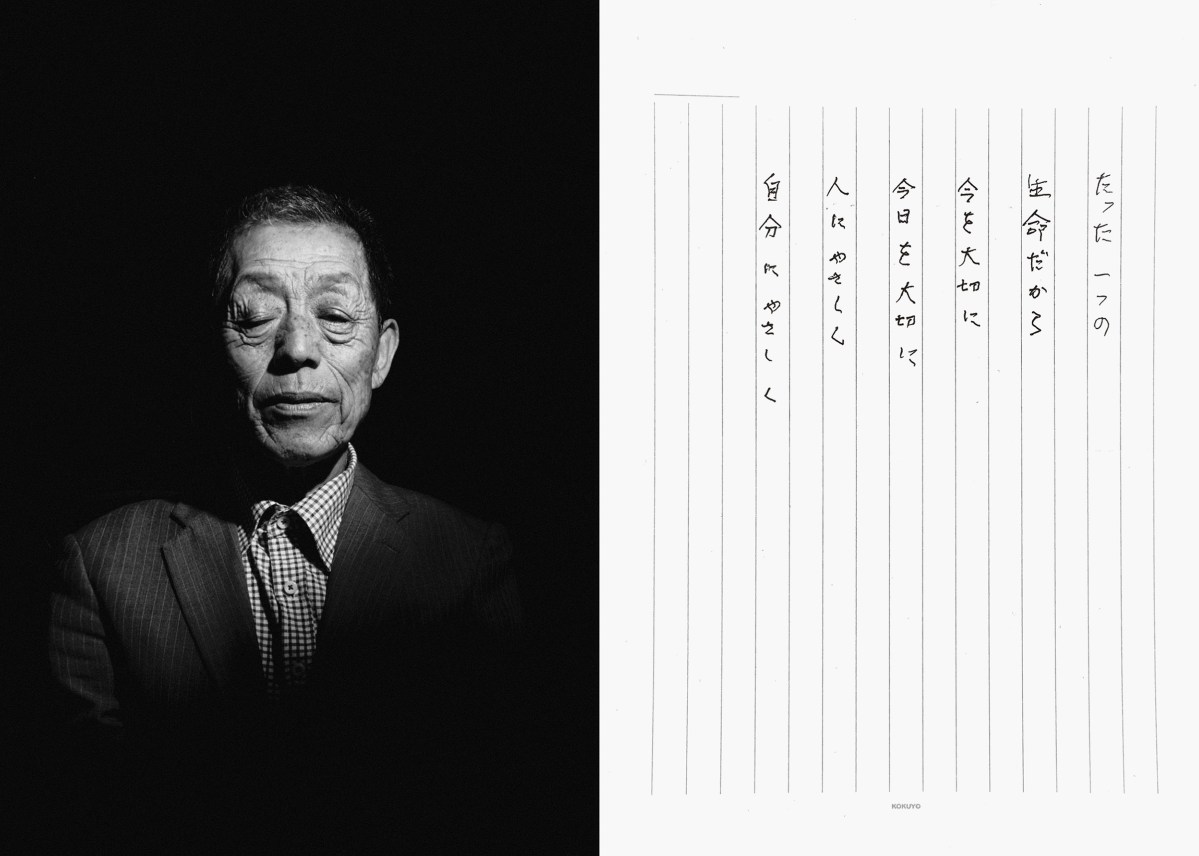
TRANSLATION
“You are only given One life, So cherish this moment Cherish this day, Be kind to others, Be kind to yourself”
TESTIMONY
“I was three years old at the time of the bombing. I don’t remember much, but I do recall that my surroundings turned blindingly white, like a million camera flashes going off at once.
Then, pitch darkness.
I was buried alive under the house, I’ve been told. When my uncle finally found me and pulled my tiny three year old body out from under the debris, I was unconscious. My face was misshapen. He was certain that I was dead.
Thankfully, I survived. But since that day, mysterious scabs began to form all over my body. I lost hearing in my left ear, probably due to the air blast. More than a decade after the bombing, my mother began to notice glass shards growing out of her skin – debris from the day of the bombing, presumably. My younger sister suffers from chronic muscle cramps to this day, on top of kidney issues that has her on dialysis three times a week. ‘What did I do to the Americans?’ she would often say, ‘Why did they do this to me?’
I have seen a lot of pain in my long years, but truthfully, I have lived a good life. As a firsthand witness to this atrocity, my only desire is to live a full life, hopefully in a world where people are kind to each other, and to themselves.”
Sachiko Matsuo
83 / Nagasaki / 1.3 km
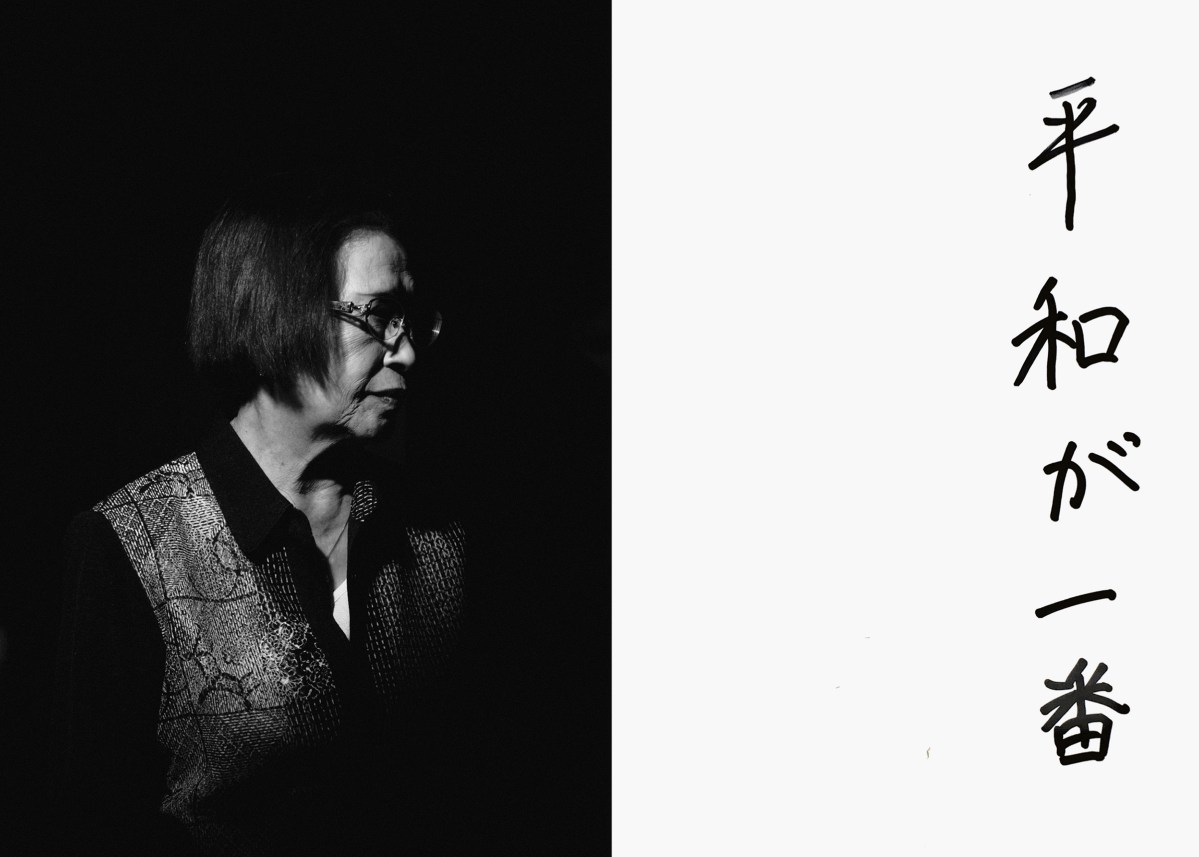
TRANSLATION
“Peace is our number one priority.”
TESTIMONY
“American B-29 bombers dropped leaflets all over the city, warning us that Nagasaki would ‘fall to ashes’ on August 8. The leaflets were confiscated immediately by the kenpei (Imperial Japanese Army). My father somehow got a hold of one, and believed what it said. He built us a little barrack up along the Iwayasan (a local mountain) to hide out in.
We went up there on the 7th, the 8th. The trail up to the barrack was rugged and steep. With several children and seniors in tow, it was a demanding trek. On the morning of the 9th, my mother and aunt opted for staying in the house. “Go back up to the barrack,” my father demanded. “The US is a day behind, remember?” When they opposed, he got very upset and stormed out to go to work.
We changed our minds and decided to hide out in the barrack, for one more day. That was a defining moment for us. At 11:02am that morning, the atomic bomb was dropped. Our family – those of us at the barrack, at least – survived the bomb.
We were later able to reunite with my father. However, he soon came down with diarrhea and a high fever. His hair began to fall out and dark spots formed on his skin. My father passed away – suffering greatly – on August 28.
If it weren’t for my father, we may have suffered severe burns like Aunt Otoku, or gone missing like Atsushi, or been lodged under the house and slowly burned to death. Fifty years later, I had a dream about my father for the first time since his death. He was wearing a kimono and smiling, ever so slightly. Although we did not exchange words, I knew at that moment that he was safe in heaven.”
Takato Michishita
78 / Nagasaki / 4.7 km
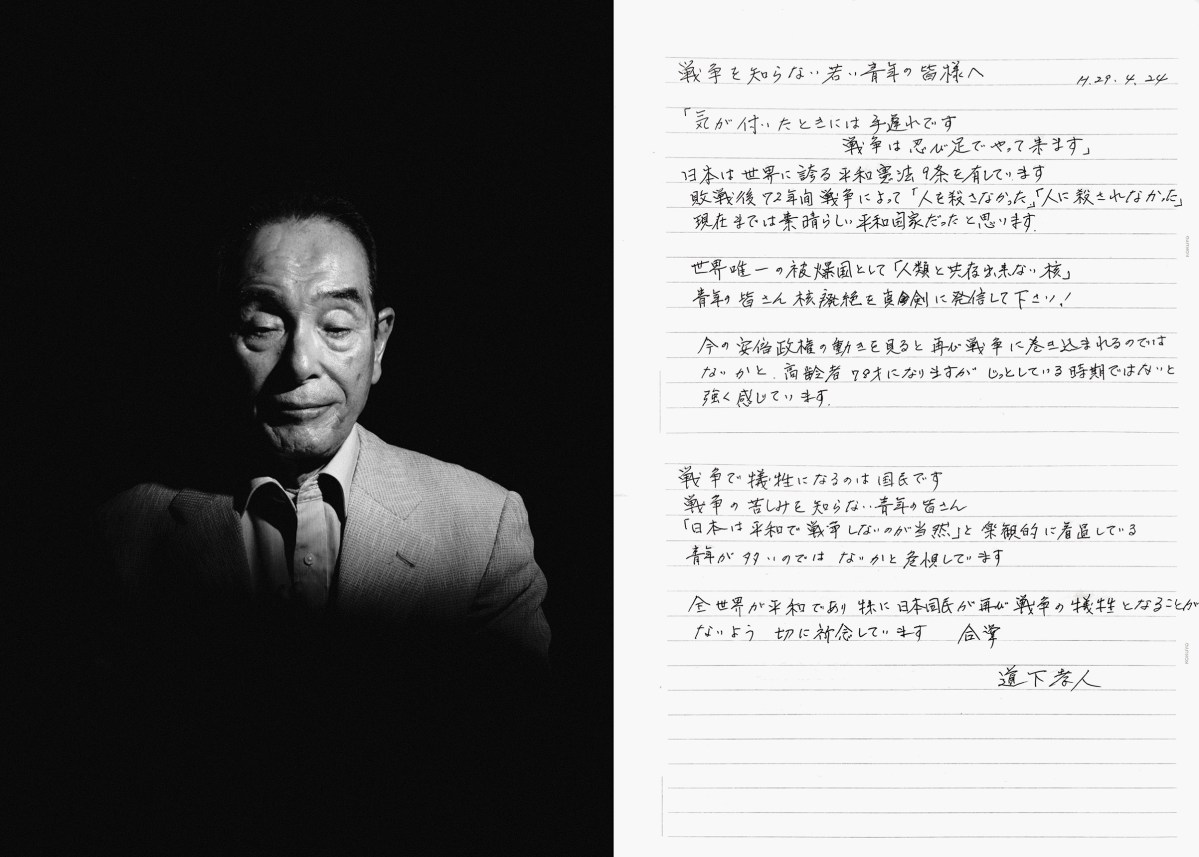
TRANSLATION
“Dear young people who have never experienced war,
‘Wars begin covertly. If you sense it coming, it may be too late.’
Within the Japanese Constitution you will find Article 9, the international peace clause. For the past 72 years, we have not maimed or been maimed by a single human being in the context of war. We have flourished as a peaceful nation.
Japan is the only nation that has experienced a nuclear attack. We must assert, with far more urgency, that nuclear weapons cannot coexist with mankind.
The current administration is slowly leading our nation to war, I’m afraid. At the ripe age of 78,
I have taken it upon myself to speak out against nuclear proliferation. Now is not the time to stand idly by.
Average citizens are the primary victims of war, always. Dear young people who have never experienced the horrors of war – I fear that some of you may be taking this hard-earned peace for granted.
I pray for world peace. Furthermore, I pray that not a single Japanese citizen falls victim to the clutches of war, ever again. I pray, with all of my heart.
TESTIMONY
“‘Don’t go to school today,’ my mother said. ‘Why?’ my sister asked.
‘Just don’t.’
Air raid alarms went off regularly back then. On August 9, however, there were no air raid alarms. It was an unusually quiet summer morning, with clear blue skies as far as the eye can see. It was on this peculiar day that my mother insisted that my older sister skip school. She said she had a ‘bad feeling.’ This had never happened before.
My sister begrudgingly stayed home, while my mother and I, aged 6, went grocery shopping. Every- one was out on their verandas, enjoying the absence of piercing warning signals. Suddenly, an old man yelled ‘Plane!’ Everyone scurried into their homemade bomb shelters. My mother and I escaped into a nearby shop. As the ground began to rumble, she quickly tore off the tatami flooring, tucked me under it and hovered over me on all fours.
Everything turned white. We were too stunned to move, for about 10 minutes. When we finally crawled out from under the tatami mat, there was glass everywhere, and tiny bits of dust and debris floating in the air. The once clear blue sky had turned into an inky shade of purple and grey. We rushed home and found my sister – she was shell-shocked, but fine.
Later, we discovered that the bomb was dropped a few meters away from my sister’s school. Every person at her school died. My mother singlehandedly saved both me and my sister that day.”
Shigeko Matsumoto
77 / Nagasaki / 800 m
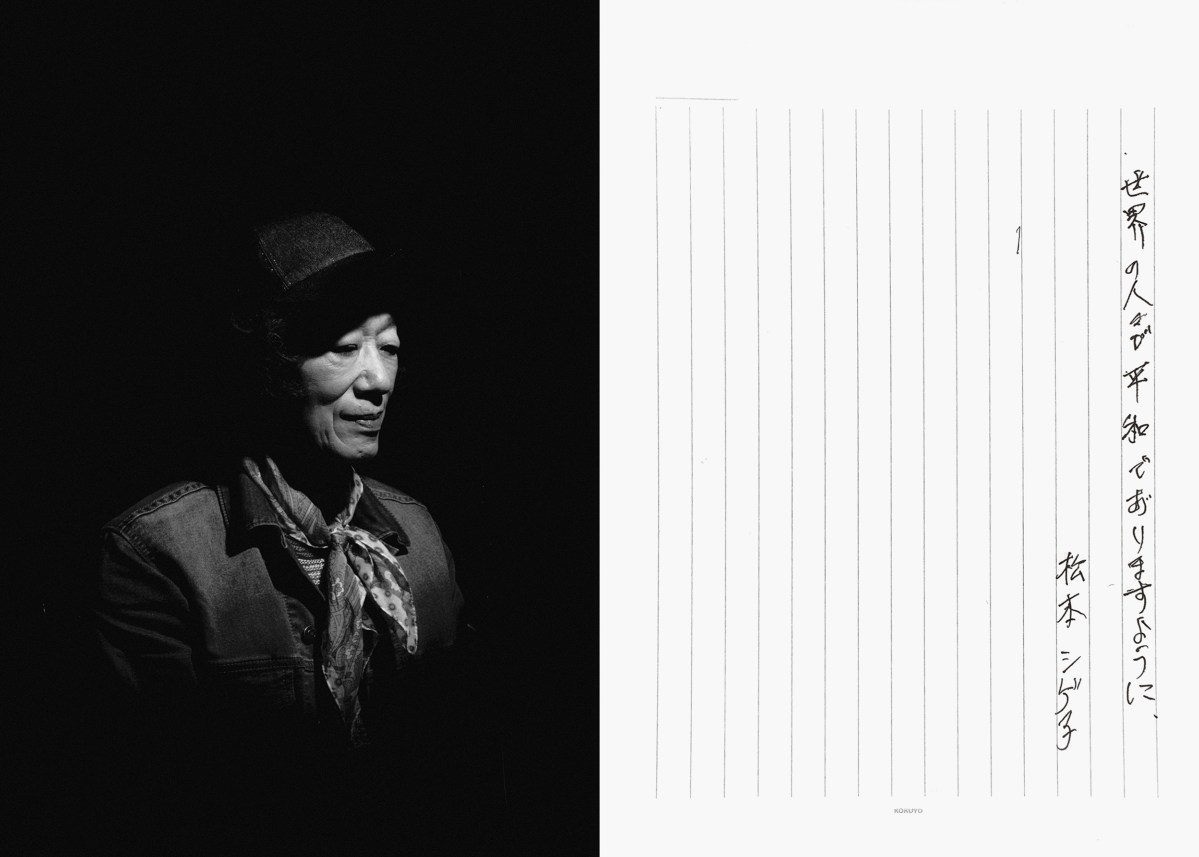
TRANSLATION
“I pray that every human being finds peace. Matsumoto Shigeko”
TESTIMONY
“There were no air raid alarms on the morning of August 9, 1945. We had been hiding out in the local bomb shelter for several days, but one by one, people started to head home. My siblings and I played in front of the bomb shelter entrance, waiting to be picked up by our grandfather.
Then, at 11:02am, the sky turned bright white. My siblings and I were knocked off our feet and violently slammed back into the bomb shelter. We had no idea what had happened.
As we sat there shell-shocked and confused, heavily injured burn victims came stumbling into the bomb shelter en masse. Their skin had peeled off their bodies and faces and hung limply down on the ground, in ribbons. Their hair was burnt down to a few measly centimeters from the scalp. Many of the victims collapsed as soon as they reached the bomb shelter entrance, forming a massive pile of contorted bodies. The stench and heat were unbearable.
My siblings and I were trapped in there for three days.
Finally, my grandfather found us and we made our way back to our home. I will never forget the hellscape that awaited us. Half burnt bodies lay stiff on the ground, eye balls gleaming from their sockets. Cattle lay dead along the side of the road, their abdomens grotesquely large and swollen. Thousands of bodies bopped up and down the river, bloated and purplish from soak- ing up the water. ‘Wait! Wait!’ I pleaded, as my grandfather treaded a couple paces ahead of me. I was terrified of being left behind.”
Yoshiro Yamawaki
83 / Nagasaki / 2.2 km
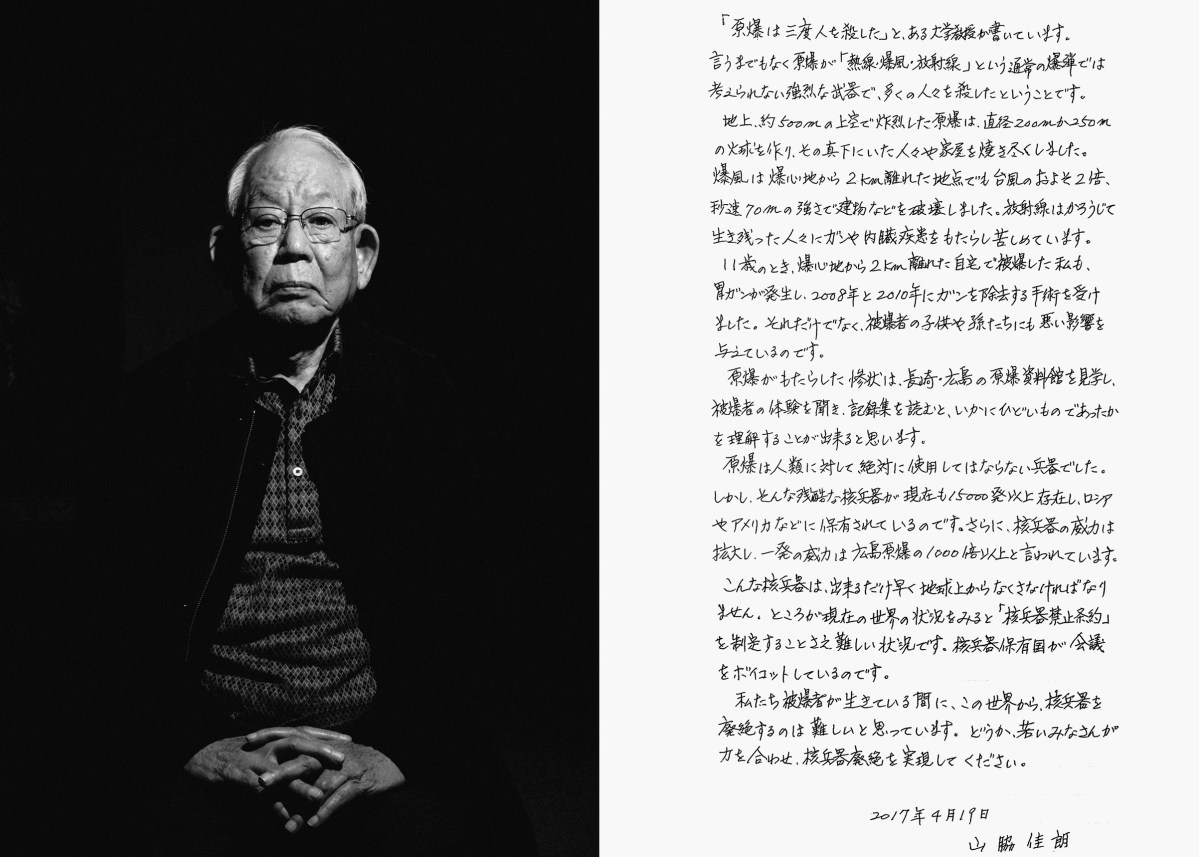
TRANSLATION
“‘The atom bomb killed victims three times,’ a college professor once said. Indeed, the nuclear blast has three components – heat, pressure wave, and radiation – and was unprecedented in its ability to kill en masse.
The bomb, which detonated 500m above ground level, created a bolide 200-250m in diameter and implicated tens of thousands of homes and families underneath. The pressure wave created a draft up to 70m/sec – twice that of a typhoon – which instantly destroyed homes 2km in radius from the hypo- center. The radiation continues to affect survivors to this day, who struggle with cancer and other debilitating diseases.
I was 11 years old when the bomb was dropped, 2km from where I lived. In recent years, I have been diagnosed with stomach cancer, and have undergone surgery in 2008 and 2010. The atomic bomb has also implicated our children and grandchildren.
One can understand the horrors of nuclear warfare by visiting the atomic bomb museums in Hiroshima
and Nagasaki, listening to first-hand accounts of hi- bakusha survivors, and reading archival documents from that period.
Nuclear weapons should, under no circumstances, be used against humans. However, nuclear powers such as the US and Russia own stockpiles of well over 15,000 nuclear weapons. Not only that, technological advances have given way to a new kind of bomb that can deliver a blast over 1,000 times that of the Hiroshima bombing.
Weapons of this capacity must be abolished from the earth. However, in our current political climate we struggle to come to a consensus, and have yet to implement a ban on nuclear weapons. This is largely because nuclear powers are boycotting the agreement.
I have resigned to the fact that nuclear weapons will not be abolished during the lifetime of us first generation hibakusha survivors. I pray that younger generations will come together to work toward a world free of nuclear weapons.
TESTIMONY
“One incident I will never forget is cremating my father. My brothers and I gently laid his blackened, swollen body atop a burnt beam in front of the factory where we found him dead and set him alight. His ankles jutted out awkwardly as the rest of his body was engulfed in flames.
When we returned the next morning to collect his ashes, we discovered that his body had been partially cremated. Only his wrists, ankles, and part of his gut were burnt properly. The rest of his body lay raw and decomposed. I could not bear to see my father like this. ‘We have to leave him here,’ I urged my brothers. Finally, my oldest brother gave in, suggesting that we take a piece of his skull – based on a common practice in Japanese funerals in which family members pass around a tiny piece of the skull with chopsticks after cremation – and leave him be.
As soon as our chopsticks touched the surface, however, the skull cracked open like plaster and his half cremated brain spilled out. My brothers and I screamed and ran away, leaving our father behind. We abandoned him, in the worst state possible.”
Emiko Okada
80 / hiroshima / 2.8 km
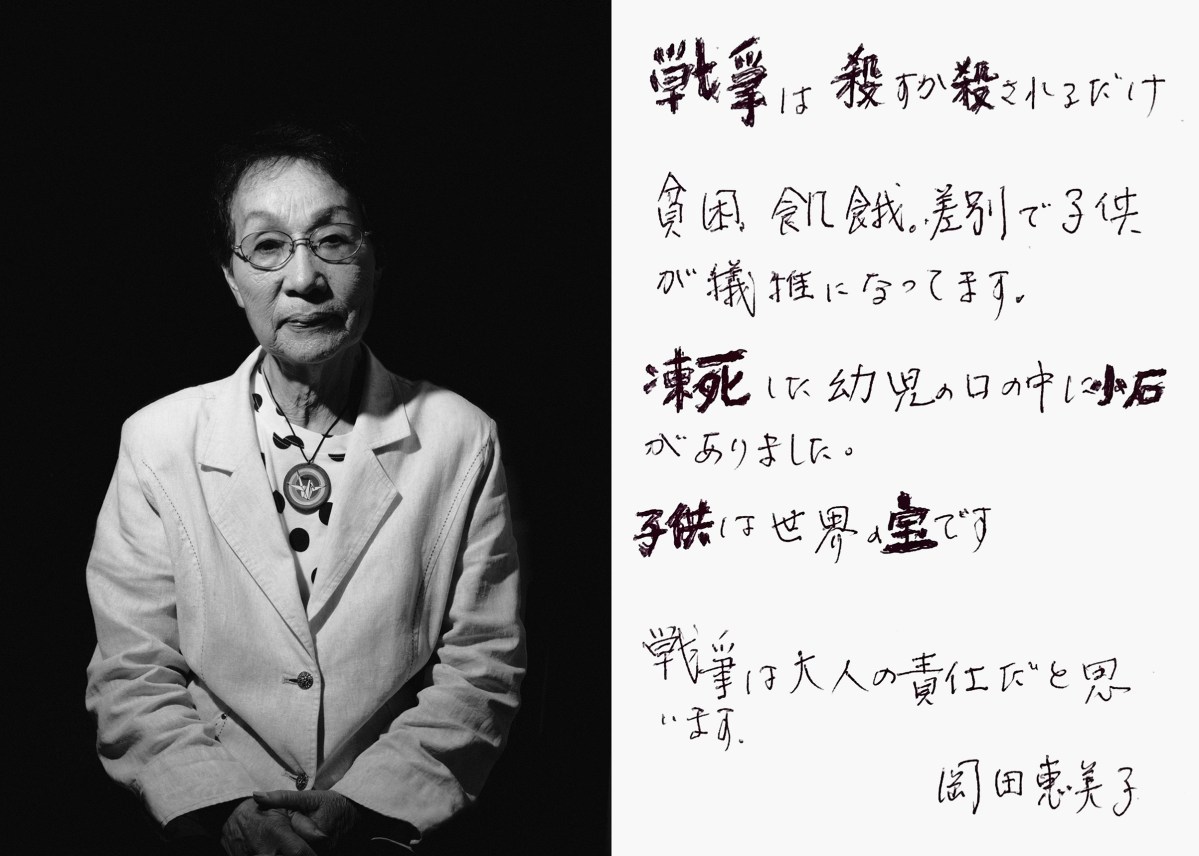
TRANSLATION
“War is one of two things: either you kill, or get killed.
Many children are victimized by poverty, malnutrition, and discrimination to this day.
I once encountered an infant who died of hypothermia. In its mouth was a small pebble.
Children are our greatest blessing.
I believe that grownups are responsible for war. Emiko Okada”
TESTIMONY
“Hiroshima is known as a ‘city of yakuza.’ Why do you think that is? Thousands of children were orphaned on August 6, 1945. Without parents, these young children had to fend for themselves. They stole to get by. They were taken in by the wrong adults. They were later bought and sold by said adults. Orphans who grew up in Hiroshima harbor a special hatred for grownups.
I was eight when the bomb dropped. My older sister was 12. She left early that morning to work on a tatemono sokai (building demolition) site and never came home. My parents searched for her for months and months. They never found her remains. My parents refused to send an obituary notice until the day that they died, in hopes that she was healthy and alive somewhere, somehow.
I too was affected by the radiation and vomited profusely after the bomb attack.
My hair fell out, my gums bled, and I was too ill to attend school. My grandmother lamented the suffering of her children and grandchildren and prayed. “How cruel, how so very cruel, if only it weren’t for the pika-don (phonetic name for the atomic bomb)…” This was a stock phrase of hers until the day that she died.
The war was caused by the selfish misdeeds of adults. Many children fell victim because of it. Alas, this is still the case today. Us adults must do everything we can to protect the lives and dignity of our children. Children are our greatest blessing.”
Masakatsu Obata
99 / nagasaki / 1.5 km
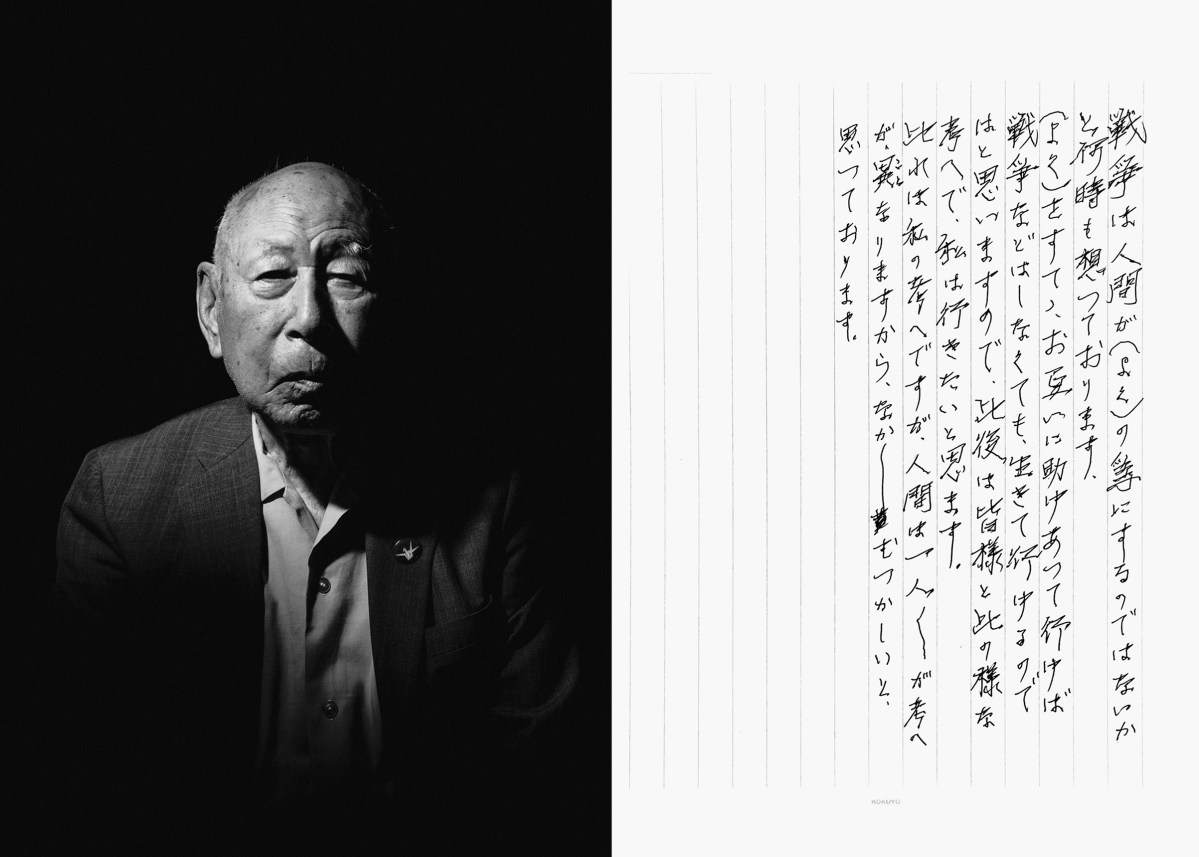
TRANSLATION
“I often think that humans go into war to satisfy their greed.
If we rid ourselves of greed and help each other instead, I believe that we will be able to coexist without war. I hope to live on with everyone else, informed by this logic.
This is just a thought of mine – each person has differing thoughts and ideologies, which is what makes things challenging.”
TESTIMONY
“I was working at the Mitsubishi factory on the morning of August 9. An alert warning went off. ‘I wonder if there will be another air raid today,’ a coworker pondered. Just then, the alert warning turned into an air raid warning.
I decided to stay inside the factory. The air raid warning eventually subsided. It must have been around 11. I started to look forward to the baked potato that I had brought for lunch that day, when suddenly, I was surrounded by a blinding light. I immediately dropped on my stomach. The slated roof and walls of the factory crumbled and fell on top of my bare back. ‘I’m going to die,’ I thought. I longed for my wife and daughter, who was only several months old.
I rose to my feet some moments later. The roof had been completely blown off our building. I peered up at the sky. The walls were also destroyed – as were the houses that surrounded the factory – revealing a dead open space. The factory motor had stopped running. It was eerily quiet. I immediately headed to a nearby air raid shelter.
There, I encountered a coworker who had been exposed to the bomb outside of the factory. His face and body were swollen, about one and a half times the size. His skin was melted off, exposing his raw flesh. He was helping out a group of young students at the air raid shelter.
‘Do I look alright?’ he asked me. I didn’t have the heart to answer. ‘You look quite swollen,’ were the only words I could muster. The coworker died three days later, or so I’ve heard.”
Kumiko Arakawa
92 / nagasaki / 2.9 km
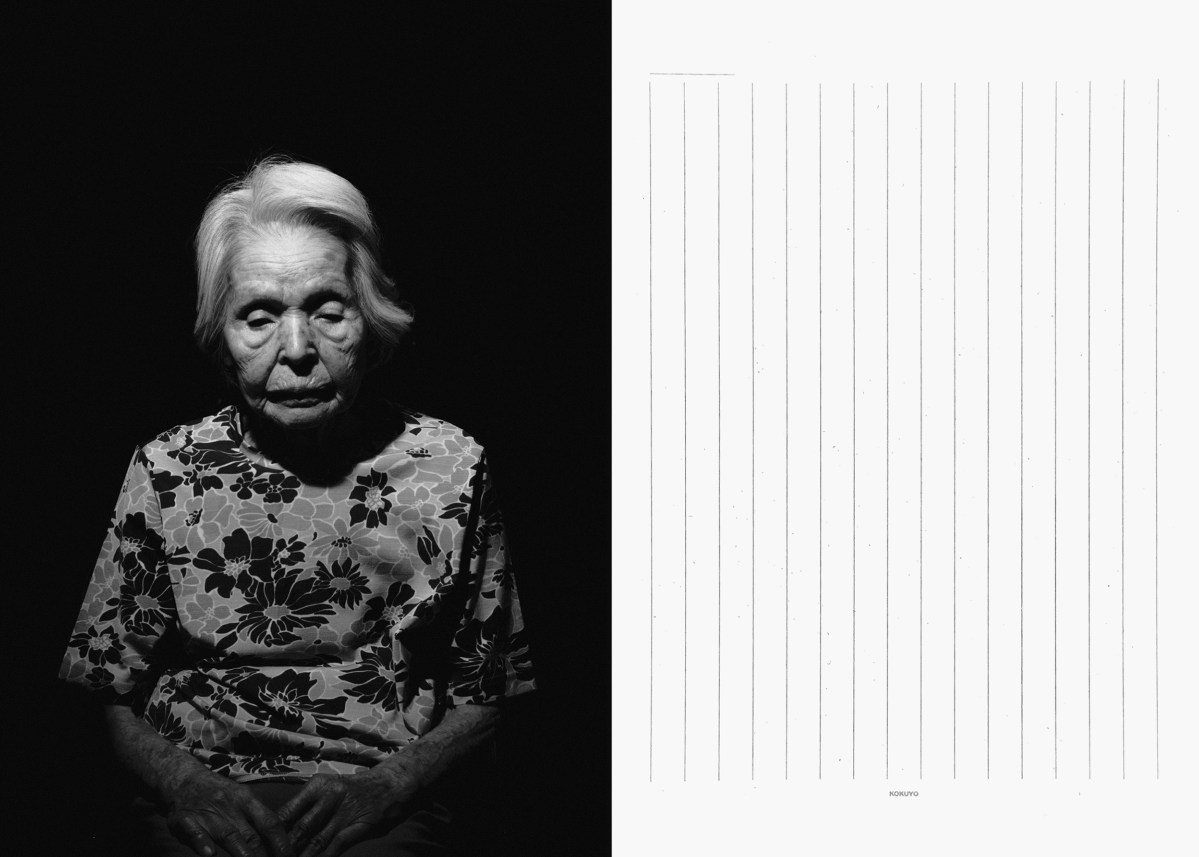
TRANSLATION
Ms. Arakawa has very little recollection of how she survived the bombing after August 9, having lost both of her parents and four siblings to the atomic bomb attack. When asked to write a message for future generations, she replied, “Nani
mo omoitsukanai (I can’t think of anything).”
TESTIMONY
“I was 20 years old when the bomb was dropped. I lived in Sakamotomachi – 500m from the hypocenter – with my parents and eight siblings. As the war situation intensified, my three youngest sisters were sent off to the outskirts and my younger brother headed to Saga to serve in the military.
I worked at the prefectural office. As of April of 1945, our branch temporarily relocated to a local school campus 2.9km away from the hypocenter because our main office was beside a wood building (author’s note: flammable in case of an air strike). On the morning of August 9, several friends and I went up to the rooftop to look out over the city after a brief air raid. As I peered up, I saw something long and thin fall from the sky. At that moment, the sky turned bright and my friends and I ducked into a nearby stairwell.
After a while, when the commotion subsided, we headed to the park for safety. Upon hearing that Sakamotoma- chi was inaccessible due to fires, I decided to stay with a friend in Oura. As I headed back home the next day, an acquaintance informed me that my parents were at an air raid shelter nearby. I headed over and found both of them suffering severe burns. They died, two days later.
My older sister was killed by the initial blast, at home. My two younger sisters were injured heavily and died within a day of the bombing. My other sister was found dead at the foyer of our house. There are countless tombstones all over Nagasaki with a name inscription but no ikotsu (cremated bone remains). I take solace in the fact that all six members of my family have ikotsu and rest together peacefully.
At age 20, I was suddenly required to support my surviving family members. I have no recollection of how I put my younger sisters through school, who we relied on, how we survived. Some people have asked me what I saw on my way home the day after the bombing, on August 10 – ‘surely you saw many dead bodies,’ they would say – but I don’t recall seeing a single corpse. It sounds strange, I’m sure – but it is the truth.
I am now 92 years old. I pray everyday that my grandchildren and great-grandchildren spend their entire lives knowing only peace.”
Fujio Torikoshi
86 / hiroshima / 2 KM
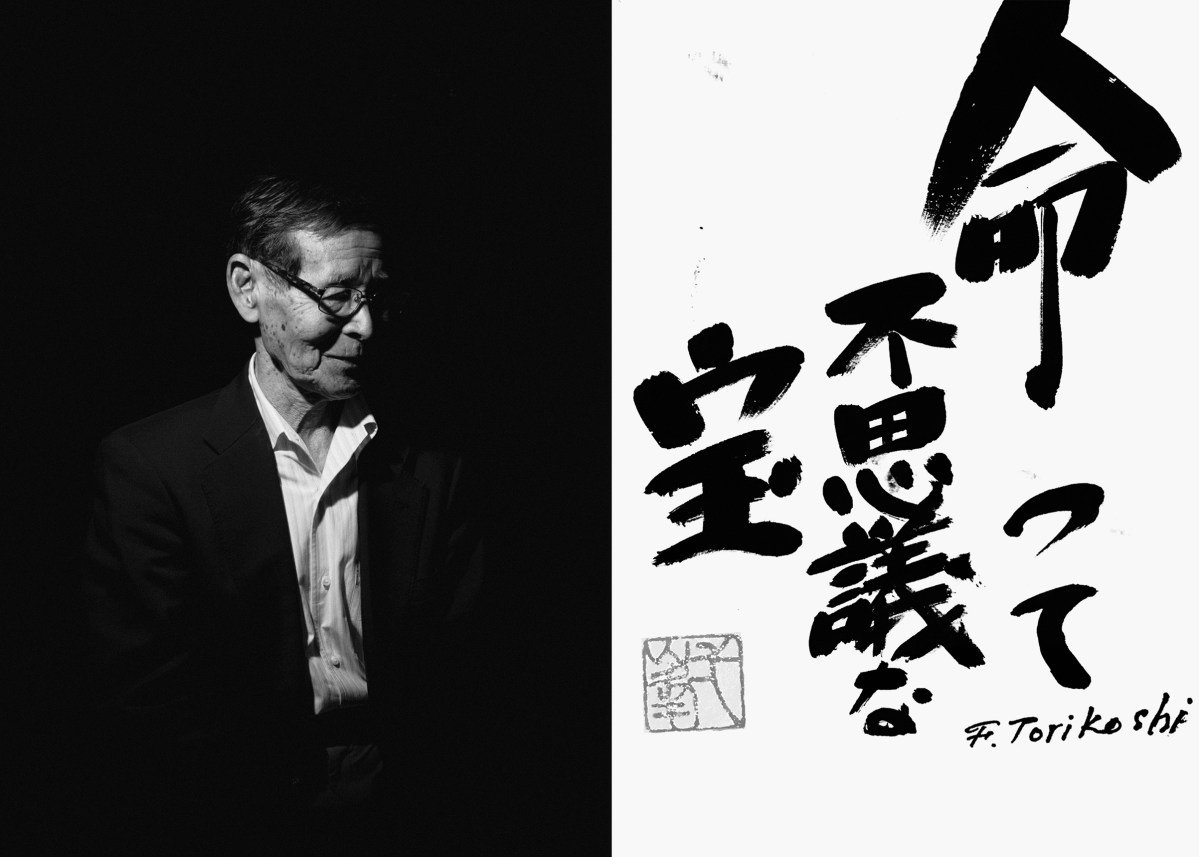
TRANSLATION
“Life is a curious treasure.”
TESTIMONY
“On the morning of August 6, I was preparing to go to the hospital with my mother. I had been diagnosed with kakke (vitamin deficiency) a few days earlier and had taken the day off school to get a medical exam. As my mother and I were eating breakfast, I heard the deep rumble of engines overhead. Our ears were trained back then; I knew it was a B-29 immediately. I stepped out into the field out front but saw no planes.
Bewildered, I glanced to the northeast. I saw a black dot in the sky. Suddenly, it ‘burst’ into a ball of blinding light that filled my surroundings. A gust of hot wind hit my face; I instantly closed my eyes and knelt down to the ground. As I tried to gain footing, another gust of wind lifted me up and I hit something hard. I do not remember what happened after that.
When I finally came to, I was passed out in front of a bouka suisou (stone water container used to extinguish fires back then). Suddenly, I felt an intense burning sensation on my face and arms, and tried to dunk my body into the bouka suisou. The water made it worse. I heard my mother’s voice in the distance. ‘Fujio! Fujio!’ I clung to her desperately as she scooped me up in her arms. ‘It burns, mama! It burns!’
I drifted in and out of consciousness for the next few days. My face swelled up so badly that I could not open my eyes. I was treated briefly at an air raid shelter and later at a hospital in Hatsukaichi, and was eventually brought home wrapped in bandages all over my body. I was unconscious for the next few days, fighting a high fever. I finally woke up to a stream of light filtering in through the bandages over my eyes and my mother sitting beside me, playing a lullaby on her harmonica.
I was told that I had until about age 20 to live. Yet here I am seven decades later, aged 86. All I want to do is forget, but the prominent keloid scar on my neck is a daily reminder of the atomic bomb. We cannot continue to sacrifice precious lives to warfare. All I can do is pray – earnestly, relentlessly – for world peace.”
Inosuke Hayasaki
86 / nagasaki / 1.1 km
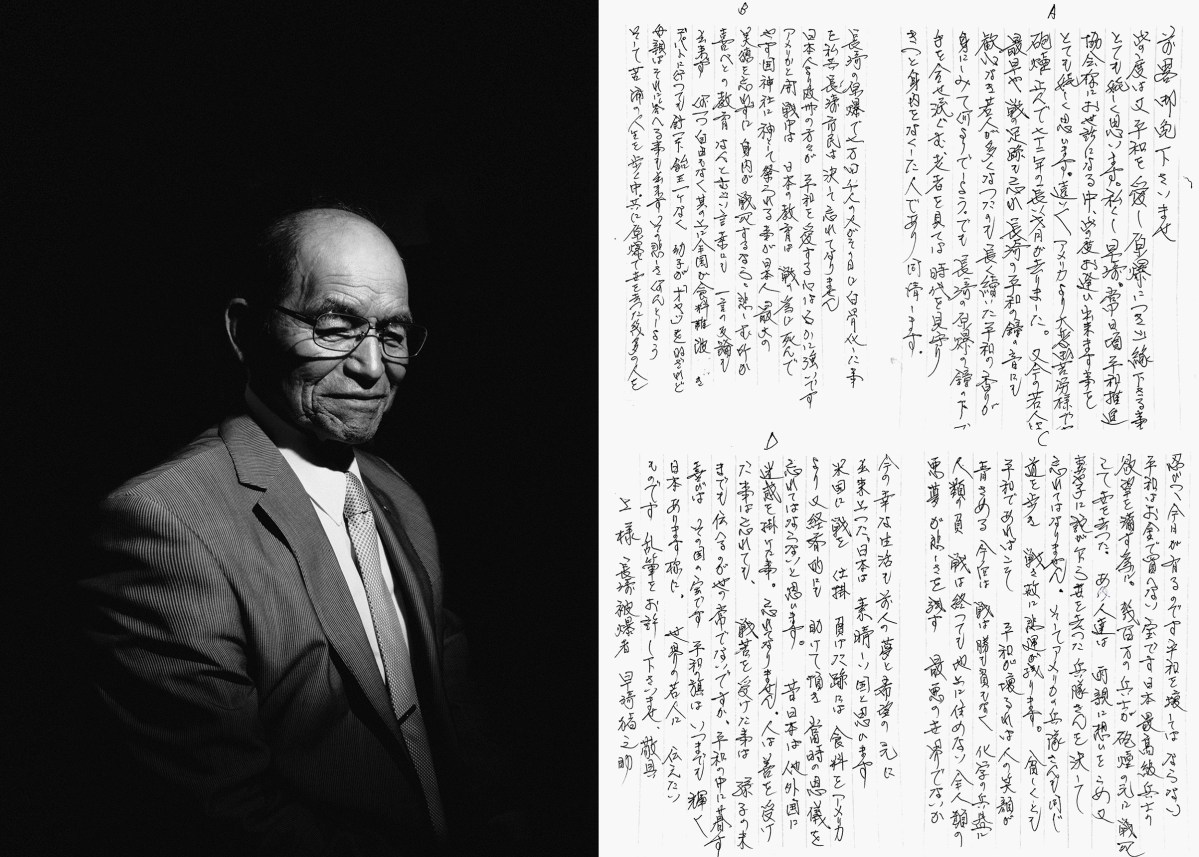
TRANSLATION
“I am very thankful for the opportunity to meet with you and speak with you about world peace and the implications of the atom bomb.
I, Hayasaki, have been deeply indebted to the Heiwasuishinkyokai for arranging this meeting, amongst many other things. You have traveled far from the US – how long and arduous your journey must have been. Seventy two years have passed since the bombing – alas, young people of this generation have forgotten the tragedies of war and many pay no mind to the Peace Bell of Nagasaki. Perhaps this is for the better, an indication that the current generation revels in peace. Still, whenever I see people of my own generation join their hands before the Peace Bell, my thoughts go out to them.
May the citizens of Nagasaki never forget the day when 74,000 people were instantaneously turned into dust. Currently, it seems Americans have a stronger desire for peace than us Japanese. During the war, we were told that the greatest honor was to die for our country and be laid to rest at the Yasukuni Shrine.
We were told that we should not cry but rejoice when family members died in the war effort. We could not utter a single word of defiance to these cruel and merciless demands; we had no freedoms. In addition, the entire country was starving – not a single treat or needle to be seen at the department store. A young child may beg his mother for a snack but she could do nothing – can you imagine how tormenting that is to a mother?
TESTIMONY
“The injured were sprawled out over the railroad tracks, scorched and black. When I walked by, they moaned in agony. ‘Water… water…’
I heard a man in passing announce that giving water to the burn victims would kill them. I was torn. I knew that these people had hours, if not minutes, to live. These burn victims – they were no longer of this world.
‘Water… water…’
I decided to look for a water source. Luckily, I found a futon nearby engulfed in flames. I tore a piece of it off, dipped it in the rice paddy nearby, and wrang it over the burn victims’ mouths. There were about 40 of them. I went back and forth, from the rice paddy to the railroad tracks. They drank the muddy water eagerly. Among them was my dear friend Yamada. ‘Yama- da! Yamada!’ I exclaimed, giddy to see a familiar face. I placed my hand on his chest. His skin slid right off, exposing his flesh. I was mortified. ‘Water…’ he murmured. I wrang the water over his mouth. Five minutes later, he was dead.
In fact, most of the people I tended to were dead.
I cannot help but think that I killed those burn victims. What if I hadn’t given them water? Would many of them have lived? I think about this everyday.”
We would not be where we are today if it weren’t for the countless lives that
were lost due to the bombing, and the many survivors who have lived in pain and struggle since. We cannot shatter this momentum of peace – it is priceless. Hundreds of thousands of soldiers died under the insurmountable greed of the Japanese military elite class. We cannot forget those young soldiers who silently longed for their parents, yearned for their wives and children as they passed away amidst the chaos of war. American soldiers have faced similar hardships. We must cherish peace, even if it leaves us poor. The smile pales when peace is taken from us. Wars of today no longer yield winners and losers – we all become losers, as our habitats become inhabitable. We must remember that our happiness today is built upon the hopes and dreams of those that passed before us.
Japan is a phenomenal country – however, we must be cognizant of the fact that we waged war on the US, and received aid from them afterwards. We must be cognizant of the pain that we inflicted upon our neighbors during the war. Fa- vors and good deeds are often forgotten, but trauma and misdeeds are passed on from one generation to the other – such is the way the world works. The ability to live in peace is a country’s most prized commodity. I pray that Japan continues to be a shining example of peace and harmony. I pray that this message resonates with young people all over the globe. Please excuse my handwriting.
Ryouga Suwa
84 / hiroshima / entered the affected area after the bombing and was exposed to radiation
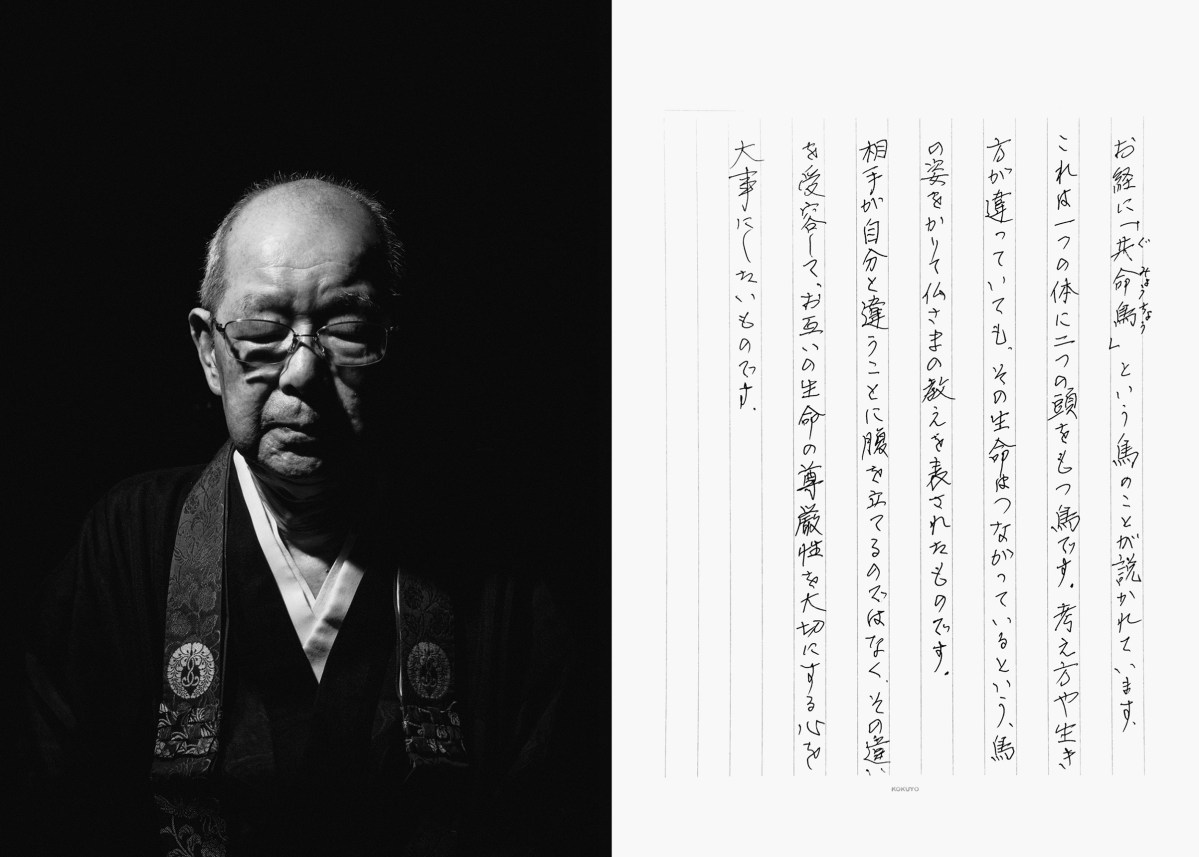
TRANSLATION
“Within the Buddhist vernacular, there is a bird called the gumyouchou. This bird has one body and two heads. Even if two entities have differing ideologies or philosophies, their lives are bound together by a single form – this is a Buddhist principle manifested in the form of a bird.
It would be ideal if we could all cultivate in us the ability to dignify each other instead of getting upset over our differences.”
TESTIMONY
“I am the 16th generation chief priest of Johoji Temple in Otemachi. The original Johoji Temple was within 500m of the hypocenter. It was instantly destroyed, along with the 1300 households that used to make up the area that is now called Hiroshima Peace Memorial Park. My parents remain missing to this day and my sister Reiko was pronounced dead.
I, on the other hand, was evacuated in Miyoshi-shi, 50km away from the hypocenter. I am what you would call a genbaku-koji (atomic bomb orphan). I was 12 years old at the time. When I returned to Hiroshima on September 16 – one month and 10 days after the bomb attack – what remained of the property was a cluster of overturned tombstones from the temple cemetery. Hiroshima was a flat wasteland. I remember feeling shocked that I could make out the Setonai Islands in the distance, which used to be inhibited by buildings.
In 1951, the temple was relocated to its current address. The new Johoji was rebuilt by the hands of our supporters and thrived along with the eventual revival of Hiroshima City. We practice an anti-war and anti-nuclear weapons philosophy here and have partnered with the Hiroshima Peace Memorial Park every year to coordinate lectures and events and pursue hibaku building restoration projects.”
Haruka Sakaguchi is a photographer based in New york City
Paul Moakley, who edited this photo essay, is time‘s Deputy Director of Photography
Lily Rothman is time‘s History and Archives Editor